This jazz guitar chord dictionary is a reference to help you find great 7th-chord voicings to play and improvise over jazz standards. The 228 chord shapes on this page are essential knowledge for any jazz guitarist and will enable you to comp chords with creativity, confidence, and variety.
Now, you don’t have to learn all of these chords at once. Instead, use this page as a resource that you come back to each time when you need to add a new chord to your vocabulary.
Have fun with these chords, get them under your fingers, and most importantly, apply them to jazz standards and chord progressions as soon as you can.
PS: If you are new to jazz guitar, check out these basic jazz guitar chords first.
CHORD TYPE LIST
- How To Read Chord Diagrams
- Basic Chords
- Shell Chords (aka Guide Tone Chords)
- Chords With Extensions
- Dominant Chords Altered Extensions
- Inversions
- Major 7 Inversions (Drop 2) – E String Root
- Major 7 Inversions (Drop 2) – D String Root
- Major 7 Inversions (Drop 3) – E String Root
- Dominant 7 Inversions (Drop 2) – E String Root
- Dominant 7 Inversions (Drop 2) – D String Root
- Dominant 7 Inversions (Drop 3) – E String Root
- Minor 7 Inversions (Drop 2) – E String Root
- Minor 7 Inversions (Drop 2) – D String Root
- Minor 7 Inversions (Drop 3) – E String Root
- Minor 7b5 Inversions (Drop 2) – E String Root
- Minor 7b5 Inversions (Drop 2) – D String Root
- Minor 7b5 Inversions (Drop 3) – E String Root
- Open Voicings
- Quartal Chords
- More Guitar Chord Lessons
How to Read Chord Diagrams
A red circle represents the root (aka 1) of the chord. Most chords in this dictionary have a C root.
The black circles are the other notes of the chord. The numbers inside the black circles indicate the chord tone.
The numbers (1, 2, 3, and 4) at the right side of each chord diagram indicate which fingers to use to fret the chord.
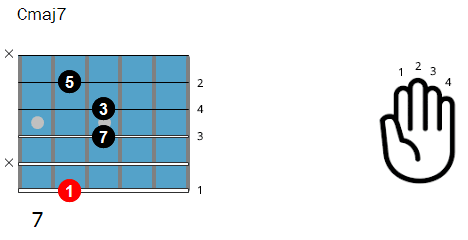
The X symbol at the left side of the chord diagram indicates that those strings are not to be played. This means that most of the chords on this page cannot be strummed, but should be played fingerstyle, with your thumb and first 3 fingers of the right hand.
The O symbol at the left side of the chord diagram indicates that those strings are played open.
Movable Chords
Most of the chords on this page are of the movable type (except the open chords). By moving the chord shapes up or down the guitar neck, you get other chords of the same chord type.
For example: move the chord shape of Cmaj7 2 frets higher and it becomes a Dmaj7.
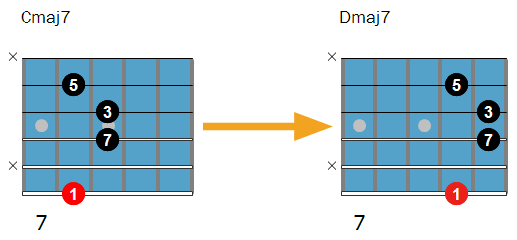
1. Basic Jazz Guitar Chords
The first group of chords is called “basic”, but they should really be described as “essential”.
These shapes contain both drop 2 and drop 3 chords in root position, which is the best place to get started with jazz guitar chords.
You will learn smaller shapes in the next section, which are easier to play, but these four-note shapes drill the sound into your ears better than the smaller shapes.
Start by learning one shape for each chord type then take those changes to a jazz tune you know or are working on.
Here are 10 great songs to practice and apply these chords to:
- Autumn Leaves
- Summertime
- All The Things You Are
- Fly Me To The Moon
- Blue Bossa
- There Will Never Be Another You
- Georgia On My Mind
- Take 5
- The Girl From Ipanema
- My Funny Valentine
Major 7 Chords
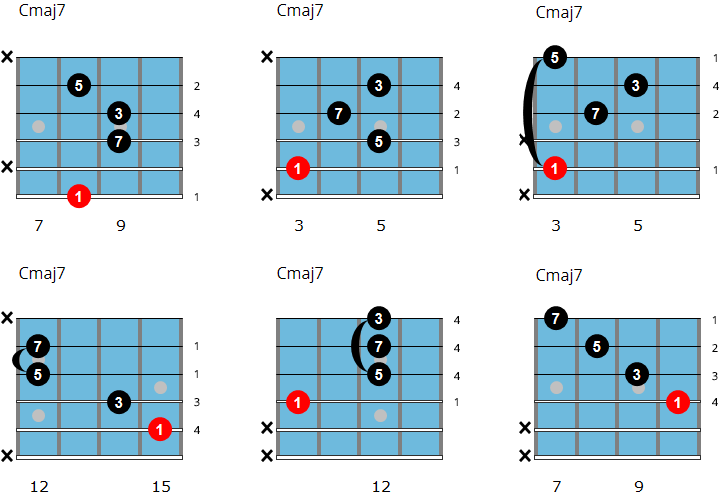
Dominant 7 Chords

Minor 7 Chords
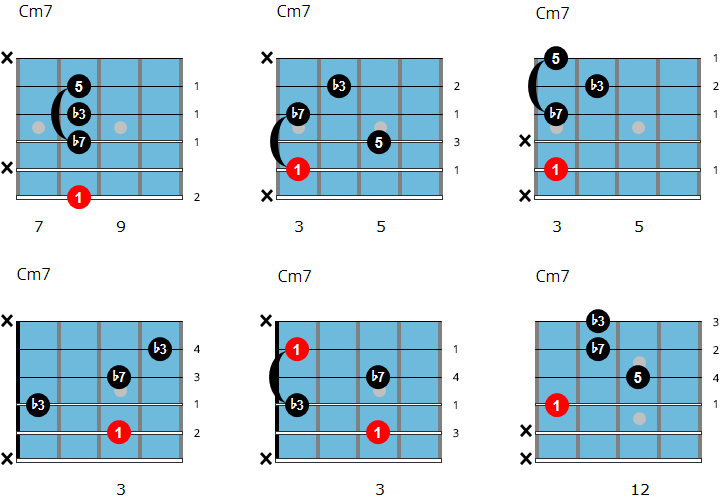
Minor 7b5 (Half-Diminished) Chords
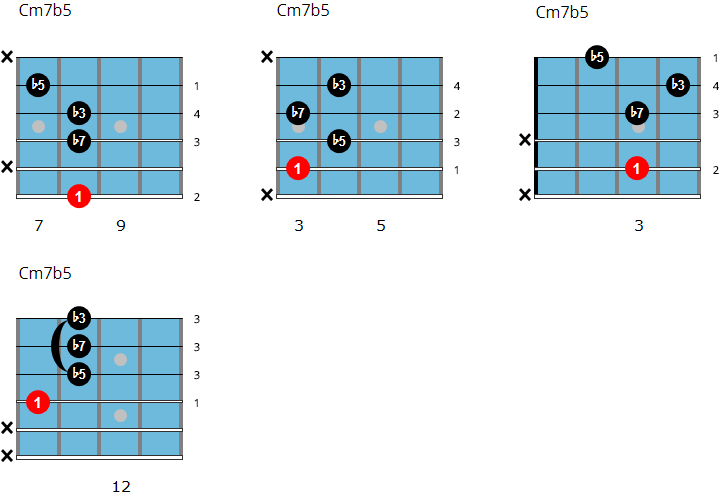
Diminished 7 Chords
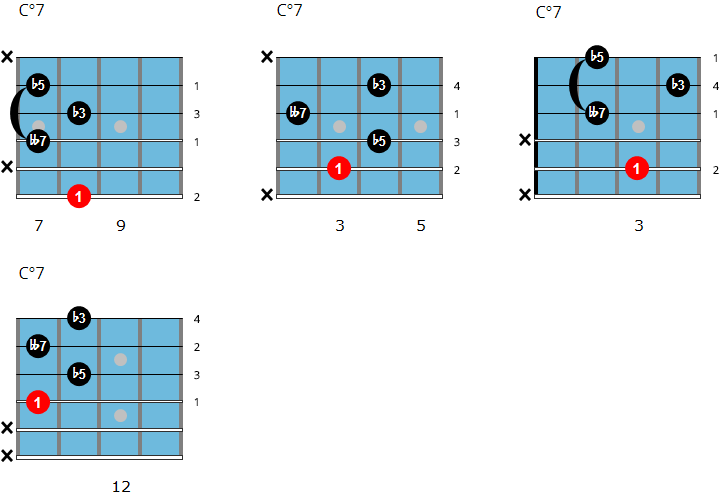
2. Shell Chords
Shell chords (aka guide tone chords) are often referred to as Freddie Green chords, as he used them to create an iconic rhythm sound with the Count Basie band.
These three-note chords contain the Root, 3rd, 7th (or the 6th).
Because of this, you just hit the essential chord tones for each shape, and mostly on the lower string sets.
Since these shapes are lower on the neck than other chord shapes, you need to keep your tone in mind so you don’t clash with the bass player in your playing.
With a softer tone these chords are highly effective when comping in a duo, trio, or larger ensembles.
1 3 7 Shell Chords (E-String Root)
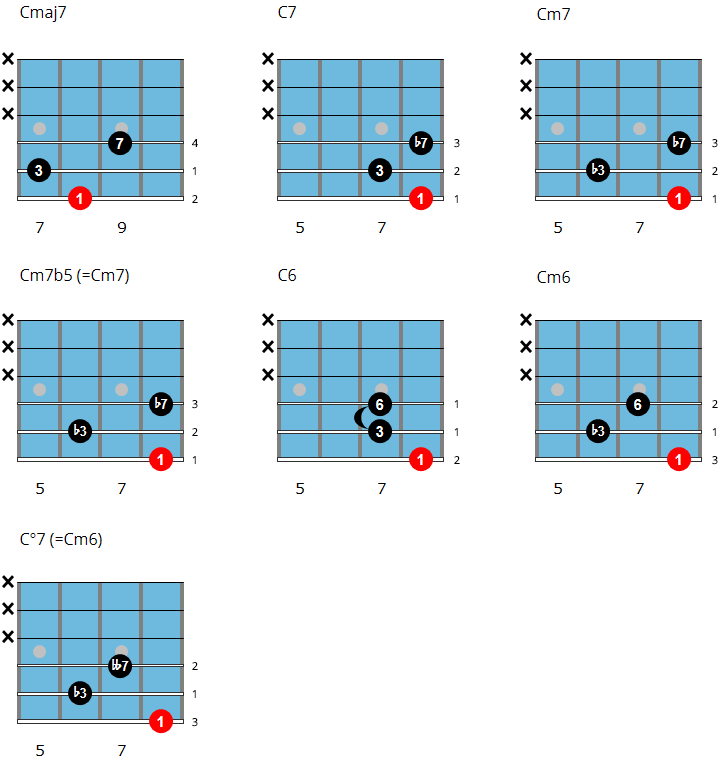
1 7 3 Shell Chords (E-String Root)
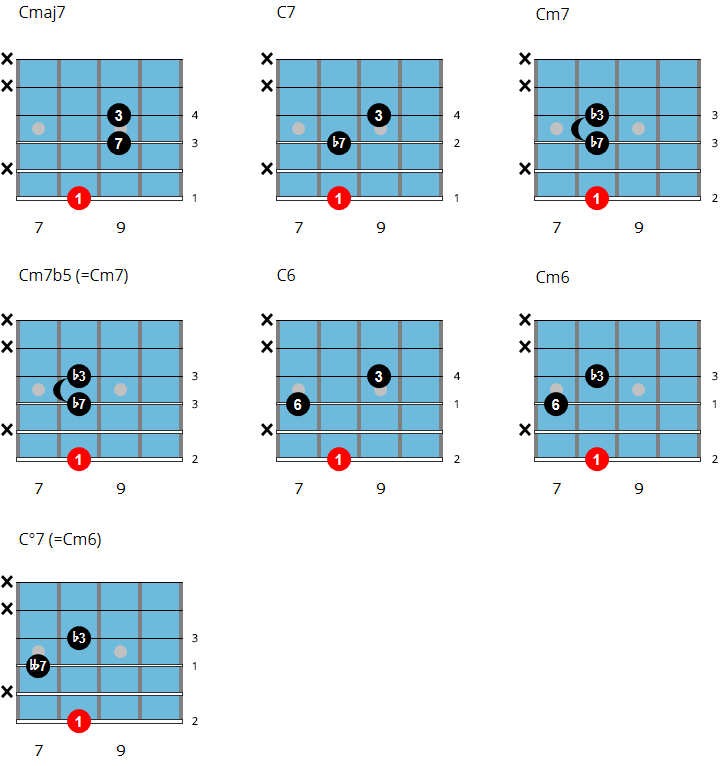
1 3 7 Shell Chords (A-String Root)

1 7 3 Shell Chords (A-String Root)
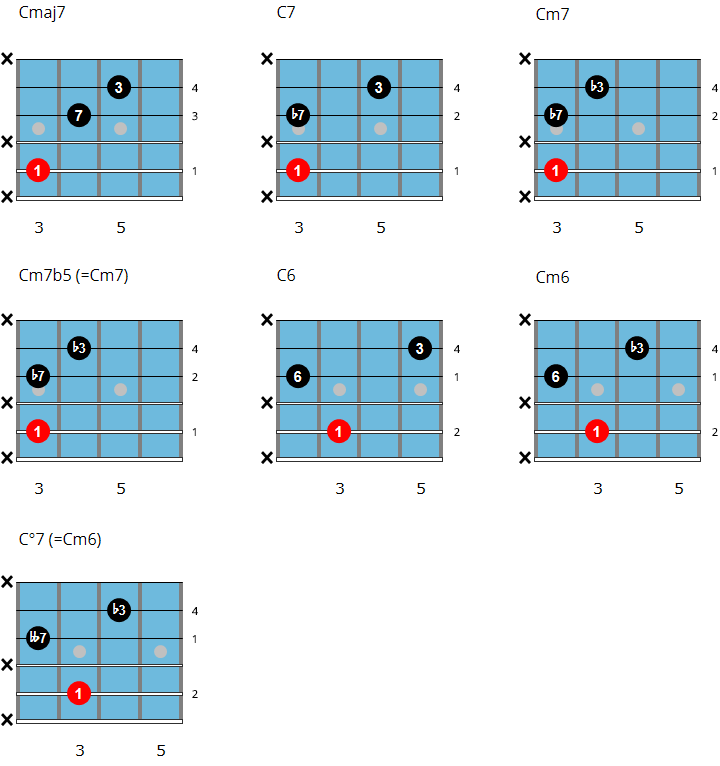
3. Chords with Extensions
Extended chords use intervals outside of the Root, 3rd, 5th, and 7th in their construction.
Because of this, we often describe these chords as more “colorful“ compared to more basic jazz guitar chords.
For each of these chord groups, an extended note replaces a lower note, such as the 6th replacing the 7th in the first group of chords for example.
Because we don’t have 10 fingers to play chords as a pianist would do, guitarists have to leave some notes out when adding extended notes to their chord shapes.
Keep that in mind, and notice which notes are replaced as you add these fun chord shapes to your harmonic vocabulary.
Major 6 Chords

Major 9 Chords
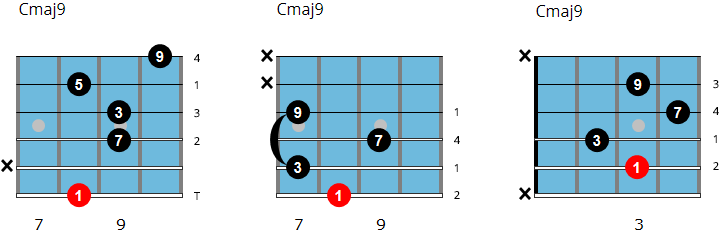

Major 6(9) Chords
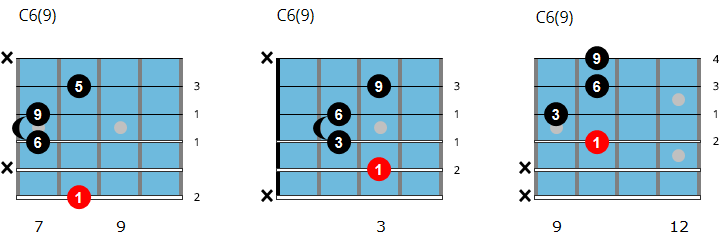
Major 13 Chords

Major 7#11 Chords
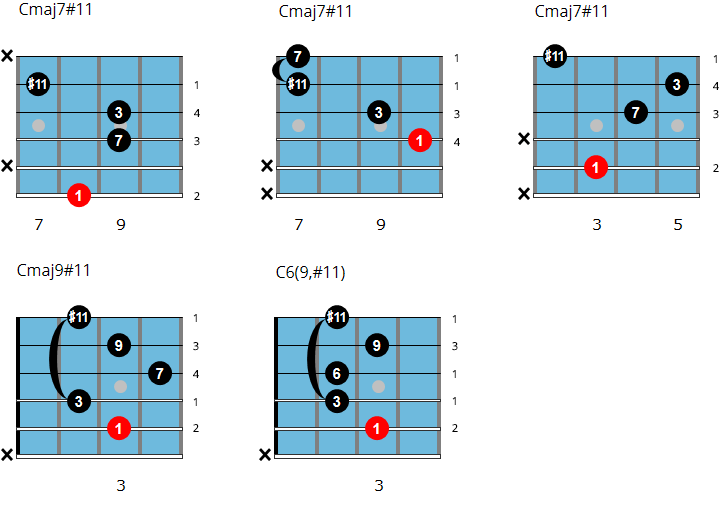
Major Augmented (Major #5) Chords
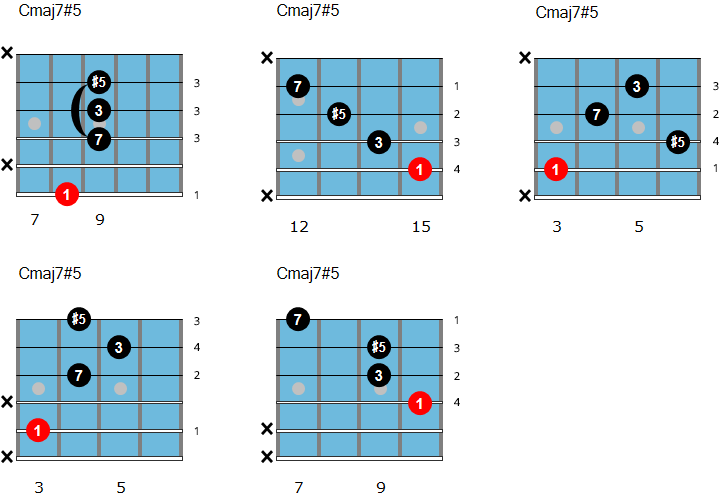
Dominant 9 Chords

Dominant 13 Chords

7 Sus 4 Chords

9 Sus 4 Chords
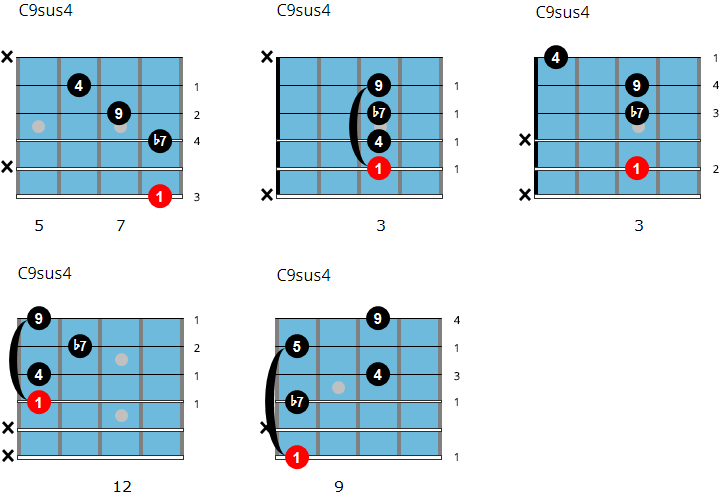
13 Sus 4 Chords

Minor 6 Chords
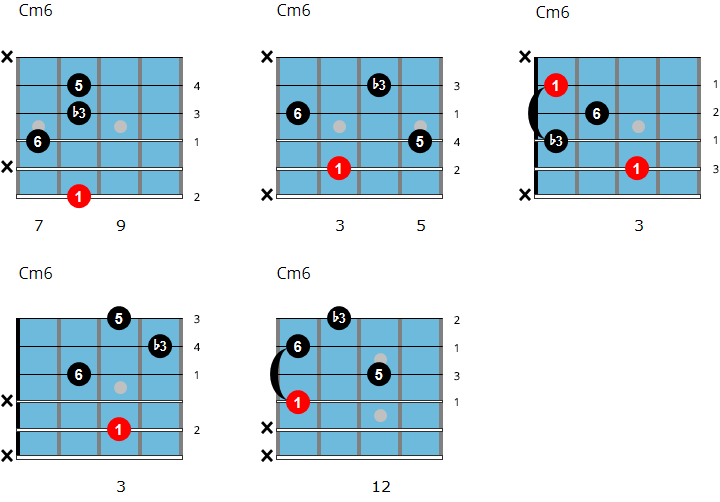
Minor 9 Chords
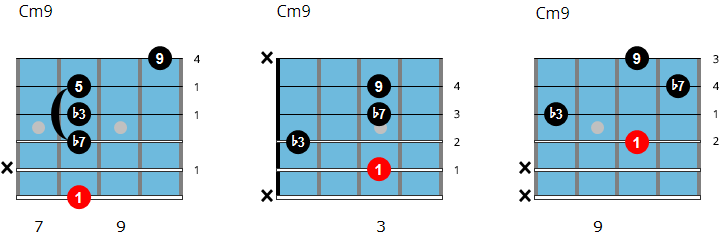
Minor 11 Chords

Minor/Major 7 Chords

Minor/Major 9 Chords

4. Dominant Chords with Altered Extensions
Besides the normal extensions (9-11-13), dominant chords can handle altered extensions, such as b9, #9, #11, and b13.
In this section you look at dominant chords with altered extensions.
These chords can be used over any dominant 7th chord in your comping to create extra tension, but if you’re new to these sounds start with them in minor keys.
For example, if you have a minor ii V I chord progression (Dm7b5-G7alt-Cm7), you can use altered extensions over the G7alt chord.
These extensions are supposed to sound tense and create tension, so if they sound “weird” to you not a problem.
Work with them and over time those outside notes will start to sound normal and more natural to your ears.
Dominant 7b9
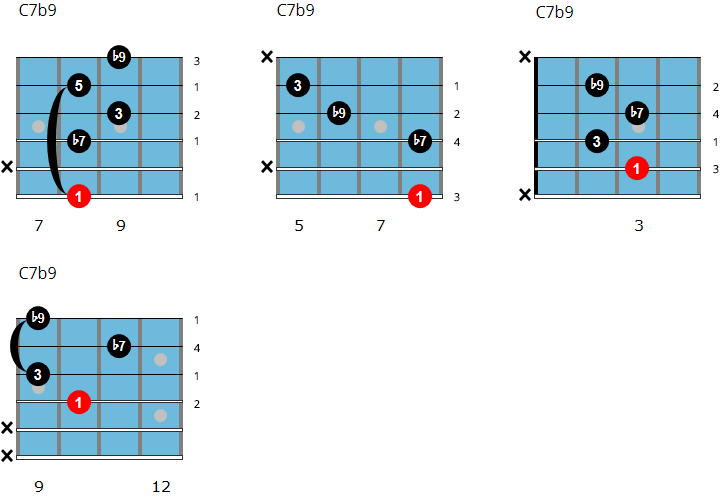
7b9 Sus 4

Dominant 13b9 / Dominant 13#9


Dominant 7#9
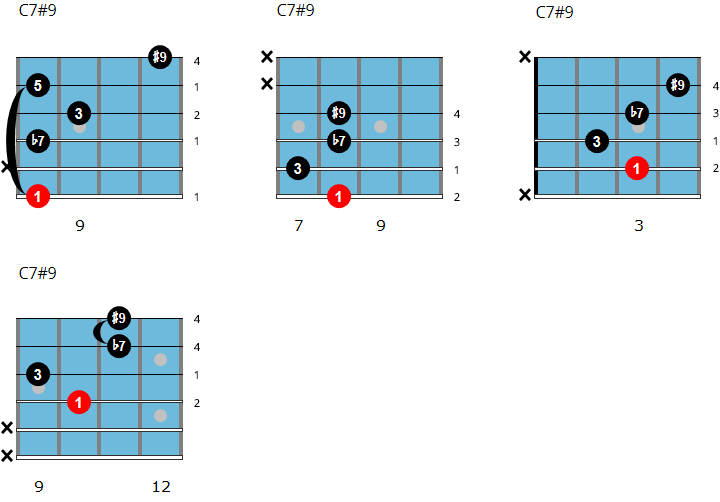
Dominant 7#11
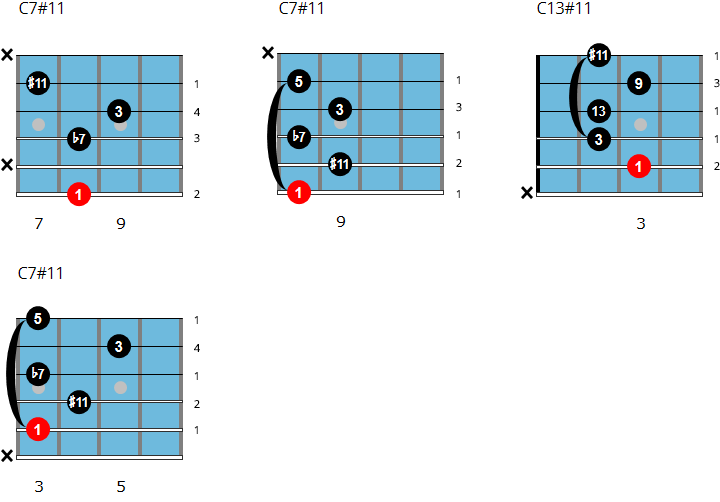
Dominant 7b13
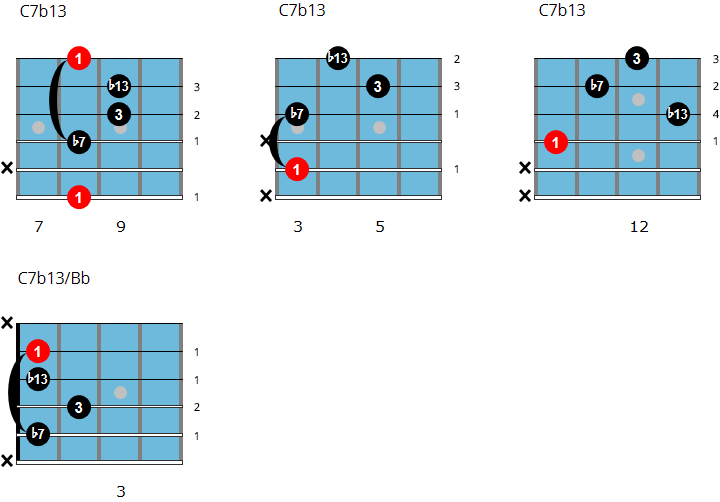
Dominant 7 (b9,b13)

Altered – 7b5(b9)

Altered – 7b5(#9)

Altered – 7#5(b9)

Altered – 7#5(#9)

5. Chord Inversions
Chord inversions use different notes in the bass than the root note.
Notice that for each group of chords, the root is in the bass for the first chord shape, then the 3rd, then 5th, and the 7th after that.
Each of these chord inversions can be applied to that chord in your comping. For example, if you see a Cmaj7 chord symbol you can play any inversion of Cmaj7.
Just know that each inversion will have a slightly different sound and some voicings will work better than others.
Though they use the same notes, putting the root or the 3rd in the bass causes the chord to have a slightly different flavor.
Major 7 Inversions (Drop 2) – E String Root

Major 7 Inversions (Drop 2) – D String Root

Major 7 Inversions (Drop 3) – E String Root

Dominant 7 Inversions (Drop 2) – E String Root

Dominant 7 Inversions (Drop 2) – D String Root

Dominant 7 Inversions (Drop 3) – E String Root

Minor 7 Inversions (Drop 2) – E String Root

Minor 7 Inversions (Drop 2) – D String Root

Minor 7 Inversions (Drop 3) – E String Root

Minor 7b5 Inversions (Drop 2) – E String Root

Minor 7b5 Inversions (Drop 2) – D String Root

Minor 7b5 Inversions (Drop 3) – E String Root

6. Open Chords
Open chords use open strings in their construction.
Though they are limited to a few keys, these shapes add new flavor to your comping in particular key centers.
Have fun with these open string chords and use them the next time you find yourself in one of these guitar-friendly keys.
Open Chords With E Root

Open Chords With A Root
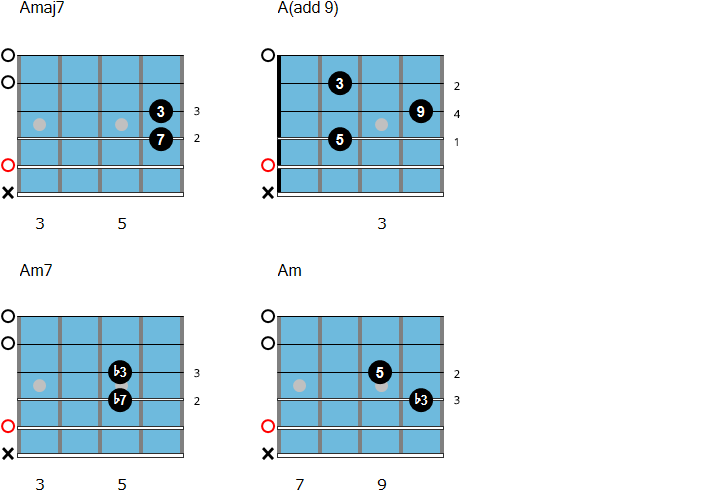
Open Chords With D Root

Open Chords With B Root

Open Chords With Bb Root

Open Chords With C Root

7. Quartal Chords
Quartal chords (aka 4th chords) are built by stacking 4th intervals above the lowest note of the chord.
These chords sound more open and modern compared to other chord types and can be used over any jazz standard in your comping.
Give these chords a try and not to worry if they sound a bit “too modern” in the beginning.
Over time they’ll become more natural to your ears and you’ll be able to apply these shapes to your playing more comfortably.
Quartal Chords Based on the C Dorian Scale (String Set 2-3-4-5)

Quartal Chords Based on the C Dorian Scale (String Set 1-2-3-4)

More Jazz Guitar Chord Lessons
The post Jazz Guitar Chord Dictionary appeared first on Jazz Guitar Online | Free Jazz Guitar Lessons, Licks, Tips & Tricks..
from Jazz Guitar Online | Free Jazz Guitar Lessons, Licks, Tips & Tricks. http://bit.ly/2Tg2CKq
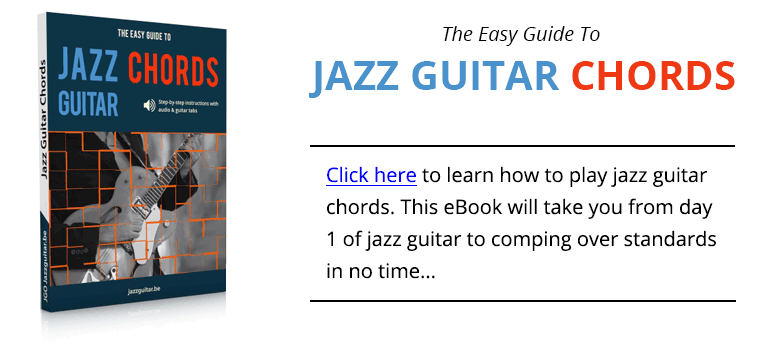
No comments:
Post a Comment